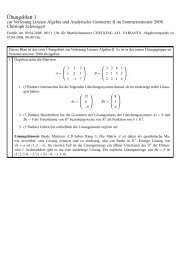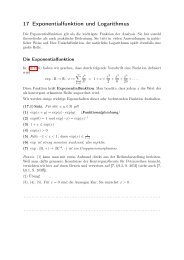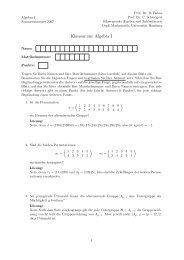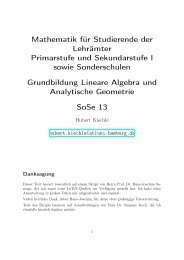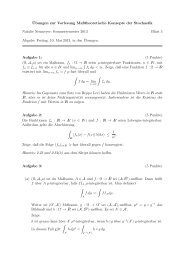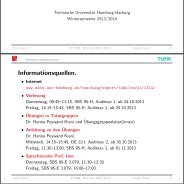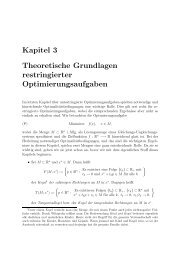pdf file
pdf file
pdf file
Create successful ePaper yourself
Turn your PDF publications into a flip-book with our unique Google optimized e-Paper software.
We take the trace Tr V0 ⊗V 0<br />
over the relation in lemma 4.3.2 and use the cyclicity of the trace to<br />
get the following equation in End (V ⊗N ).<br />
C(μ) ∙ C(ν) = Tr V0 ⊗V 0<br />
T 0 (μ)T 0 (ν)<br />
= Tr V0 ⊗V 0<br />
R 00 (λ) −1 T 0 (ν)T 0 (μ)R 00 (λ)<br />
= C(ν)C(μ)<br />
✷<br />
Example 4.3.4.<br />
We consider the case of two possible states for each bond. One represents the state of a bond<br />
by assigning to it a direction, denoted by an arrow. A famous model is then the XXX model<br />
or six vertex model. In this case, one assigns Boltzmann weight zero to all vertices, except for<br />
those with two ingoing and two outgoing vertices. These are the following six configurations,<br />
hence the name of the model:<br />
Since now V is two-dimensional, the R-matrix is a 4 × 4-matrix<br />
⎛<br />
⎞<br />
1 0 0 0<br />
R(q, λ) = ⎜ 0 λ 1 − qλ 0<br />
⎟<br />
⎝ 0 1 − q −1 λ λ 0 ⎠<br />
0 0 0 1<br />
This model is integrable with the relation<br />
λ − μ + ν + λμν = (q + q −1 )λν .<br />
4.4 The square of the antipode of a quasi-triangular Hopf algebra<br />
We have seen in corollary 2.5.9 that for a cocommutative Hopf algebra, the square of the<br />
antipode obeys S 2 = id H . For quasi-triangular Hopf algebras, a weaker statement still holds. We<br />
assume throughout this chapter that the antipode S is invertible. This condition is automatically<br />
fulfilled by theorem 3.1.13.3 for finite-dimensional Hopf algebras. The reader might wish to check<br />
for which propositions the existence of a skew-antipode as in remark 2.5.8 is sufficient.<br />
Proposition 4.4.1.<br />
Let (H, R) be a quasi-triangular Hopf algebra. Then the element<br />
is invertible with inverse<br />
u := S(R (2) ) ∙ R (1) ∈ H<br />
u −1 := S −1 (R (2) ) ∙ R (1) ,<br />
where R −1 = R (1) ⊗ R (2) . For all h ∈ H, we have<br />
S 2 (h) = uhu −1 = (Su) −1 hS(u)<br />
so that the square of the antipode is an inner automorphism.<br />
100






